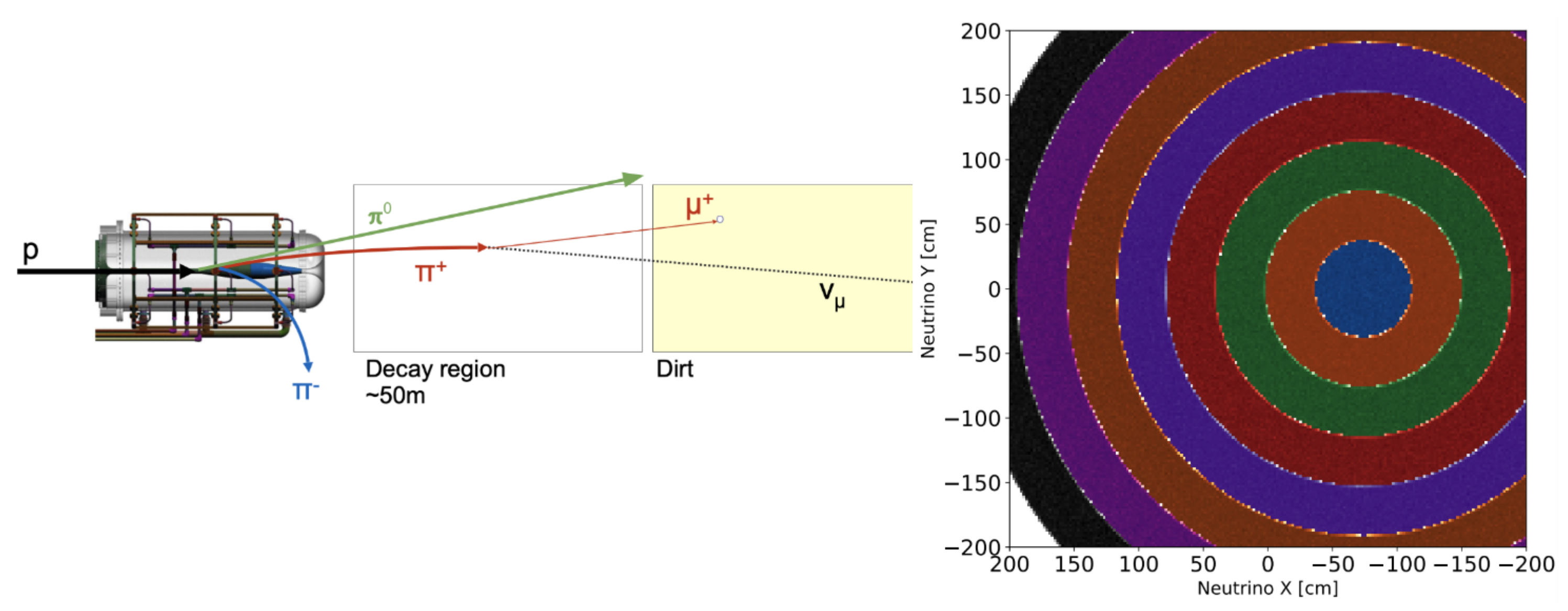Beyond the Standard Model New Physics Searches with SBND †
Abstract
:1. Introduction
2. The SBND Experiment
2.1. Time Projection Chamber
2.2. Photon Detection System
2.3. Cosmic Ray Tagger
2.4. SBND PRISM
3. Beyond the Standard Model with SBND
3.1. Millicharged Particles
3.2. Heavy Neutral Leptons
3.3. Light Dark Matter
3.4. Dark Neutrinos
4. Summary
Funding
Institutional Review Board Statement
Informed Consent Statement
Data Availability Statement
Conflicts of Interest
References
- Acciarri, R.; Adams, C.; An, R.; Andreopoulos, C.; Ankowski, A.M.; Antonello, M.; Asaadi, J.; Badgett, W.; Bagby, L.; Baibussinov, B.; et al. A Proposal for a Three Detector Short-Baseline Neutrino Oscillation Program in the Fermilab Booster Neutrino Beam. arXiv 2015, arXiv:1503.01520. [Google Scholar]
- Acciarri, R.; Adams, C.; An, R.; Aparicio, A.; Aponte, S.; Asaadi, J.; Auger, M.; Ayoub, N.; Bagby, L.; Baller, B.; et al. Design and Construction of the MicroBooNE Detector. J. Instrum. JINST 2017, 12, P02017. [Google Scholar] [CrossRef]
- Amerio, S.; Amoruso, S.; Antonello, M.; Aprili, P.; Armenante, M.; Arneodo, F.; Badertscher, A.; Baiboussinov, B.; Ceolin, M.B.; Battistoni, G.; et al. Design, construction and tests of the ICARUS T600 detector. Nucl. Instrum. Meth. A 2004, 527, 329–410. [Google Scholar] [CrossRef]
- Aguilar-Arevalo, A.A.; Brown, B.C.; Bugel, L.; Cheng, G.; Conrad, J.M.; Cooper, R.L.; Dharmapalan, R.; Diaz, A.; Djurcic, Z.; Finley, D.A.; et al. Significant Excess of Electronlike Events in the MiniBooNE Short-Baseline Neutrino Experiment. Phys. Rev. Lett. 2018, 121, 221801. [Google Scholar] [CrossRef] [PubMed]
- The MicroBooNE Collaboration. Search for an Excess of Electron Neutrino Interactions in MicroBooNE Using Multiple Final-State Topologies. Phys. Rev. Lett. 2022, 128, 241801. [Google Scholar] [CrossRef] [PubMed]
- The MicroBooNE Collaboration. Search for Neutrino-Induced Neutral-Current Δ Radiative Decay in MicroBooNE and a First Test of the MiniBooNE Low Energy Excess under a Single-Photon Hypothesis. Phys. Rev. Lett. 2022, 128, 111801. [Google Scholar] [CrossRef] [PubMed]
- Machado, A.A.; Segreto, E.; Warner, D.; Fauth, A.; Gelli, B.; Máximo, R.; Pissolatti, A.; Paulucci, L.; Marinho, F. The X-ARAPUCA: An improvement of the ARAPUCA device. J. Instrum. 2018, 13, C04026. [Google Scholar] [CrossRef]
- Bhadra, S.; Blondel, A.; Bordoni, S.; Bravar, A.; Bronner, C.; Caravaca-Rodriguez, J.; Dziewiecki, M.; Feusels, T.; Fiorentini-Aguirre, G.A.; Friend, M.; et al. Letter of Intent to Construct a nuPRISM Detector in the J-PARC Neutrino Beamline. arXiv 2014, arXiv:1412.3086. [Google Scholar]
- Dobroliubov, M.I.; Ignatiev, A.Y. Millicharged Particles. Phys. Rev. Lett. 1990, 65, 679–682. [Google Scholar] [CrossRef] [PubMed]
- Magill, G.; Plestid, R.; Pospelov, M.; Tsai, Y.D. Millicharged Particles in Neutrino Experiments. Phys. Rev. Lett. 2019, 122, 071801. [Google Scholar] [CrossRef] [PubMed]
- Asaka, T.; Shaposhnikov, M. The νMSM, Dark Matter and Baryon Asymmetry of the Universe. Phys. Lett. B 2005, 620, 17–26. [Google Scholar] [CrossRef]
- Asaka, T.; Blanchet, S.; Shaposhnikov, M. The νMSM, Dark Matter and Neutrino Masses. Phys. Lett. B 2005, 631, 151–156. [Google Scholar] [CrossRef]
- The MicroBooNE Collaboration. Search for heavy neutral leptons decaying into muon-pion pairs in the MicroBooNE detector. Phys. Rev. D 2020, 101, 052001. [Google Scholar] [CrossRef]
- Deniverville, P.; Chen, C.Y.; Pospelov, M.; Ritz, A. Light dark matter in neutrino beams: Production modeling and scattering signatures at MiniBooNE, T2K, and SHiP. Phys. Rev. D 2017, 95, 035006. [Google Scholar] [CrossRef]
- Bertuzzo, E.; Jana, S.; Machado, P.A.; Funchal, R.Z. Neutrino masses and mixings dynamically generated by a light dark sector. Phys. Lett. B 2019, 791, 210–214. [Google Scholar] [CrossRef]





Disclaimer/Publisher’s Note: The statements, opinions and data contained in all publications are solely those of the individual author(s) and contributor(s) and not of MDPI and/or the editor(s). MDPI and/or the editor(s) disclaim responsibility for any injury to people or property resulting from any ideas, methods, instructions or products referred to in the content. |
© 2023 by the author. Licensee MDPI, Basel, Switzerland. This article is an open access article distributed under the terms and conditions of the Creative Commons Attribution (CC BY) license (https://creativecommons.org/licenses/by/4.0/).
Share and Cite
Balasubramanian, S., on behalf of the SBND Collaboration. Beyond the Standard Model New Physics Searches with SBND. Phys. Sci. Forum 2023, 8, 68. https://doi.org/10.3390/psf2023008068
Balasubramanian S on behalf of the SBND Collaboration. Beyond the Standard Model New Physics Searches with SBND. Physical Sciences Forum. 2023; 8(1):68. https://doi.org/10.3390/psf2023008068
Chicago/Turabian StyleBalasubramanian, Supraja on behalf of the SBND Collaboration. 2023. "Beyond the Standard Model New Physics Searches with SBND" Physical Sciences Forum 8, no. 1: 68. https://doi.org/10.3390/psf2023008068
APA StyleBalasubramanian, S., on behalf of the SBND Collaboration. (2023). Beyond the Standard Model New Physics Searches with SBND. Physical Sciences Forum, 8(1), 68. https://doi.org/10.3390/psf2023008068




